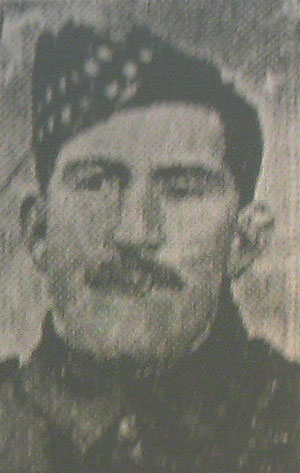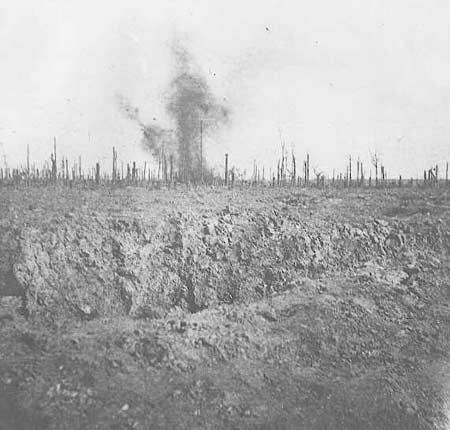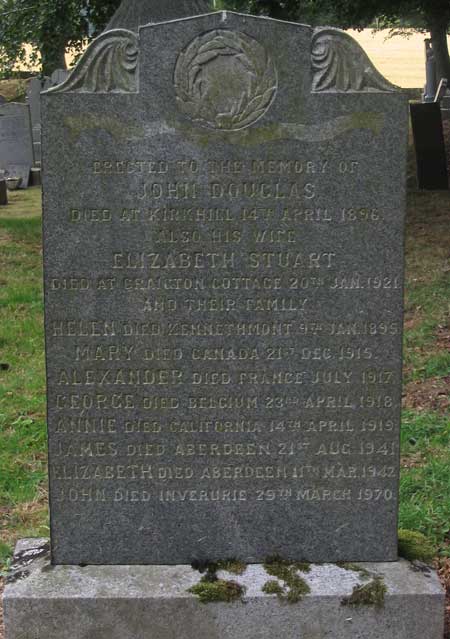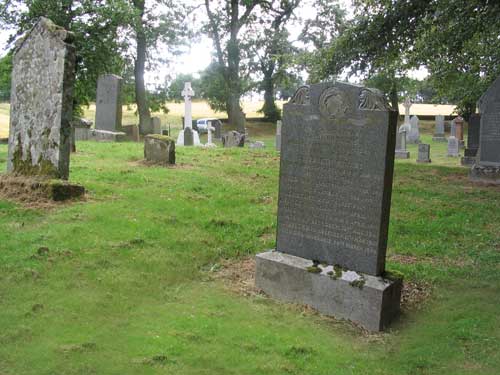|
Private Alexander
Douglas, 1st Batt, Gordon Highlanders Alexander
Douglas , the eldest son of John and Elizabeth Douglas was born at
Kirkhill, Kennethmont on 26th May 1890. His father, a farm servant
at Netherton, Clatt and then
Seggieden, died six years later. Having been called up or by volunteering
Alexander enlisted in the 1st Battalion of the Gordon Highlanders
at Inverurie.
The letter S in his army service number S/11238 indicates his was
a wartime enlistment. At that time his widowed mother and her four
sons were living at Craigton Cottage. All of them were to join up
with the Gordon Highlanders.
Item from The People's Journal, January 1917. George
in 6th Batt, Gordon Highlanders was wounded in action near Bethune, died a Prisoner of War on 11th April 1918 ,and is buried in Tournai Communal Cemetery Allied
Extension
The 1st Battalion
Gordon Highlanders, a regular army battalion in the 8th Brigade, 3rd
Division, were sent to help defend France and Flanders following the
German invasion of Belgium on 4th August 1914. They landed at Boulogne
on 14th August 1914 and by forced marches," this contemptible
little army " as the German Kaiser scoffingly called the British
force, arrived near Mons in Begium on 22nd August. There they lined
the Condee - Mons Canal near Nimy Bridge. This salient was to become
the main point of the German army thrust at 9am the following morning.
Bitter fighting followed in which the Gordons suffered very heavy
casualties. At 3pm the 3rd Division was ordered to retire. Then began
the long march back to Le Cateau where they were to stand their ground
against the invader on the night of 25th August in defensive positions
in front of Audencourt and Caudry. Following the disaster at Le Cateau the 1st Gordons were reorganised and was eventually to be joined by Alexander Douglas. The beginning of 1916 finds the 1st Gordons repeating the routine of trenches and billets south of Ypres in Belgium. From billets in Reninghelst, La Clytte and Locre they moved in and out of trenches at Kemmel and St Eloi. They were relieved at Kemmel at the end of May and rested in billets at Bailleul. On 11th June they begin the combination of exercises and training marches arriving at the final training area at Moulle, Somme on 18th June. The rest of June was spent there training for the attack and musketry practice on the ranges.
A German shell explodes on Delville Wood 1916
1GH were not involved in the disastrous Somme assaults of July 1st
1916. They were a few miles behind the lines at Franvilliers at this
time and from 7th July at Bronfay Farm, Bray-sur-Somme practising
assaults night and day. They moved up the line to trenches at Caterpillar
Valley near Longueval, so called due to the long narrow caterpillar
shaped wood which ran alongside it, on the 13th. They took part in
the general attack on the German positions at 3.25 the following day
in the sector of front which was to see the fiercest conflict of all.
View of part of Delville Wood in September 1916 The 1st Gordons were called upon to attempt the task and at 3.45 on 18th July they stormed Longueval village, the orchard to the north and Delville Wood. They penetrated through the wood to the crest line beyond, falling on the slopes before a raking machine gun fire. They withstood a concentrated bombardment and repulsed repeated counter attacks for 8 hours. Then, having suffered very heavy losses, including Pte Alexander Douglas who was posted " missing in action" , they were forced to withdraw to trenches at the south end of the village. The Battalion War Diary entry for that day records
18 July - Caterpillar Valley --------------------------------------------- They were relieved on 26th July.
The strength of this infamous German position can be gauged by the
fact that it was not wholly in British hands until August 25th 1916.
Due to the horrors which occurred there as it changed hands many times
Delville Wood was known to the soldiers as Devil's Wood. Alexander Douglas has no known grave and is commemorated with 74,000 other men on the nearby Thiepval Memorial who are also "Missing on the battlefields of the Somme"
The Douglas family headstone in Kennethont (Old) Kirkyard ~~~~ Alexander died France July 1917 ~~~~ A press report in Jan 1917 states that Alexander had been missing in action since July 18th 1916.
The Douglas family grave with the Kennethmont WW1 memorial in the background |






